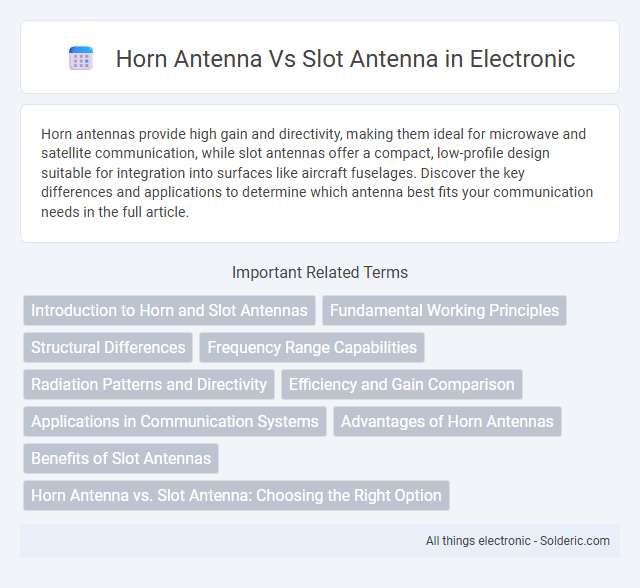Horn antennas provide high gain and directivity, making them ideal for microwave and satellite communication, while slot antennas offer a compact, low-profile design suitable for integration into surfaces like aircraft fuselages. Discover the key differences and applications to determine which antenna best fits your communication needs in the full article.
Comparison Table
| Feature | Horn Antenna | Slot Antenna |
|---|---|---|
| Design | Flared waveguide opening | Slot cut in conductive surface |
| Frequency Range | Microwave frequencies (1 GHz to 40 GHz) | VHF to microwave (100 MHz to several GHz) |
| Radiation Pattern | Directional, high gain beam | Directional but generally broader beam |
| Gain | Typically 10-20 dBi | Typically 5-12 dBi |
| Polarization | Linear (usually) | Linear or circular based on slot design |
| Size | Relatively large at lower frequencies | Compact, low profile |
| Common Applications | Radar, satellite communication, microwave links | Aircraft, RFID, integrated antenna arrays |
| Impedance Matching | Well matched to waveguide | Requires careful design for impedance |
| Manufacturing Complexity | Moderate, precise waveguide fabrication | Low to moderate, simpler slot cutting |
Introduction to Horn and Slot Antennas
Horn antennas, widely used in microwave frequencies, feature flared metal waveguides that efficiently direct radio waves and enhance gain with minimal signal loss. Slot antennas, consisting of narrow apertures cut into conductive surfaces, offer compact size and wide bandwidth, making them ideal for applications requiring planar integration. Your choice between these antennas depends on factors such as frequency range, radiation pattern, and installation constraints.
Fundamental Working Principles
Horn antennas operate by gradually flaring a waveguide into a horn shape, efficiently directing radio waves through impedance matching and reducing signal reflection to achieve high gain and directivity. Slot antennas function by radiating electromagnetic waves from a narrow slot cut into a conductive surface, where the slot dimensions determine resonant frequency and polarization characteristics. Both antenna types convert guided waves into free-space radiation but differ fundamentally in their physical structure and electromagnetic wave propagation mechanisms.
Structural Differences
Horn antennas feature a flared metal waveguide that gradually expands to form a conical or pyramidal shape, enhancing directivity and gain by efficiently radiating energy. Slot antennas consist of narrow openings or slots cut into a metallic surface, acting as radiating elements with unique polarization properties and compact size. The primary structural difference lies in the horn's three-dimensional, open-ended design versus the slot antenna's planar, surface-integrated configuration.
Frequency Range Capabilities
Horn antennas typically operate effectively across a wide frequency range, from UHF through millimeter waves, making them suitable for applications requiring high gain and directional performance at microwave frequencies. Slot antennas generally function within narrower bands, often in the GHz range, and are commonly used in applications like radar and communication systems where compact size and planar integration are important. Understanding your frequency range needs helps determine whether a horn antenna or a slot antenna is more suitable for reliable signal transmission and reception.
Radiation Patterns and Directivity
Horn antennas exhibit a high directivity with a narrow radiation pattern, making them ideal for point-to-point communication and radar applications requiring focused beams. Slot antennas typically have broader radiation patterns and lower directivity, suitable for applications needing wide-angle coverage such as broadcasting or mobile devices. Understanding the differences in radiation patterns and directivity helps optimize your antenna choice for specific communication needs.
Efficiency and Gain Comparison
Horn antennas typically exhibit higher gain and efficiency due to their well-designed flared structure that directs electromagnetic waves with minimal loss. Slot antennas, while compact and easier to integrate into surfaces, generally have lower gain and efficiency because of their inherent impedance mismatch and surface wave losses. The efficiency of horn antennas often exceeds 80%, with gains ranging from 10 to 20 dBi, whereas slot antennas usually offer gains between 5 and 10 dBi with efficiency closer to 50-70%.
Applications in Communication Systems
Horn antennas excel in satellite communications and radar systems due to their high directivity and gain, making them ideal for long-distance signal transmission. Slot antennas, favored in compact and mobile communication devices, offer wide bandwidth and easy integration into planar surfaces, enhancing your system's flexibility. Both antenna types serve crucial roles in communication systems by balancing performance requirements with design constraints.
Advantages of Horn Antennas
Horn antennas offer high directivity and gain, making them ideal for microwave frequency applications requiring focused signal transmission. Their simple design enables low reflection and wide bandwidth performance, enhancing overall antenna efficiency. Horn antennas also provide excellent impedance matching, reducing signal loss and ensuring stable, reliable communication.
Benefits of Slot Antennas
Slot antennas offer a compact and low-profile design ideal for integration into surfaces without protruding elements, making them suitable for applications with space constraints. Their inherently wide bandwidth and linear polarization contribute to efficient signal transmission and reception across diverse frequency ranges. You benefit from their ease of fabrication and compatibility with printed circuit boards, enabling cost-effective mass production in wireless communication systems.
Horn Antenna vs. Slot Antenna: Choosing the Right Option
Horn antennas offer high gain and directivity, making them ideal for applications requiring focused energy transmission, such as radar and satellite communications. Slot antennas provide compact size and ease of integration into surfaces, suitable for applications needing efficient space utilization like in phased arrays and wireless devices. Your choice depends on whether you prioritize directional performance and gain or space-saving design and integration flexibility.
horn antenna vs slot antenna Infographic

 solderic.com
solderic.com